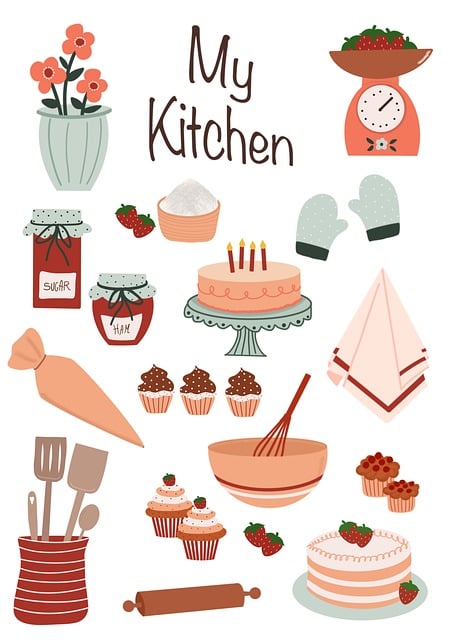To achieve a timeless kitchen style, classic design principles like clean lines and symmetrical layouts form the foundation. Decorative moldings, corbels, and trim subtly enhance these principles, adding depth and character without clutter. Strategically used, these elements transform ordinary kitchens into captivating spaces that encourage gathering and conversation, with various styles available to suit any taste or interior design goal. Balance and harmony are key, ensuring decorative features harmonize with the space's architecture for an elegant, cohesive look that transcends fleeting trends.
Discover the secret to achieving an elegant, timeless kitchen style with classic detailing. From decorative moldings and corbels to intricate trim, these architectural elements can transform your space into a sophisticated sanctuary. Explore how understanding time-honored design principles empowers you to create a harmonious blend of form and function. Learn the art of incorporating each element for a look that’s both classic and timeless.
Understanding Timeless Classic Design Principles
In the pursuit of achieving a timeless kitchen style, understanding classic design principles is paramount. These guidelines, honed over centuries, offer a sense of balance, harmony, and elegance that transcends fleeting trends. Classic kitchens often feature clean lines, symmetrical layouts, and a thoughtful interplay between form and function. Incorporating decorative moldings, corbels, and trim serves as a subtle yet powerful tool to enhance these principles, adding depth and character without overwhelming the space.
The strategic use of these classic elements can elevate a kitchen from ordinary to extraordinary. Moldings, for instance, can frame doors and windows, drawing the eye and defining spaces. Corbels, with their supportive yet decorative nature, add visual interest to countertops or as part of a hood. Trim, whether on cabinets or walls, provides a finishing touch that completes the overall aesthetic. By adhering to timeless design principles and thoughtfully integrating these classic details, homeowners can create kitchens that are both stunning and enduring.
The Role of Decorative Moldings in Kitchen Aesthetics
Decorative moldings play a pivotal role in crafting a timeless kitchen style, adding depth and character to even the most modern or traditional spaces. These architectural details serve as framing elements, drawing the eye and defining areas within the kitchen. For example, crown molding can be used to elevate cabinets, creating an elegant transition between walls and countertops. Corbels, with their supportive yet decorative nature, can grace islands or support shelves, infusing a sense of craftsmanship and balance.
When incorporated thoughtfully, moldings and corbels become more than mere aesthetics; they contribute to the overall flow and functionality of the kitchen. By defining zones, they help create visual interest while providing structural support where needed. This subtle yet powerful touch can transform a mundane kitchen into a captivating space that invites gathering and conversation—the heart of any home, after all.
Corbels: Adding Architectural Charm and Support
Corbels, those elegant architectural elements, are a simple yet powerful way to enhance any space and bring a touch of classic charm to your timeless kitchen style. These supporting brackets, often seen under shelves or over doors, serve both functional and aesthetic purposes. Not only do they provide structural support, but they also add visual interest and dimension to your interior design.
With various styles and designs available, corbels can be tailored to complement different decor themes. From traditional wooden corbels that exude warmth and sophistication to ornate metal ones that boast a touch of elegance, these details can transform a mundane kitchen feature into a standout architectural element. Whether you’re aiming for a cozy, rustic atmosphere or a sleek, modern look, corbels offer a versatile way to elevate your timeless kitchen style.
Incorporating Trim for Elegance and Detail
Incorporating trim is a powerful way to elevate any space, particularly in aiming for a timeless kitchen style. From sleek moldings that define cabinets and countertops to intricate corbels supporting overhead elements, these decorative additions bring a sense of elegance and sophistication. Trim serves as the finishing touch, allowing homeowners to showcase their taste and create a cohesive, classic aesthetic.
Each detail, from the choice of wood species to the profile of the molding, contributes to the overall look and feel of the kitchen. For example, simple yet elegant baseboards can ground the space while crown moldings add vertical depth and character. Corbels, with their classic design, provide structural support and a touch of grandeur, making them ideal for creating a timeless kitchen style that stands the test of time.
Achieving Harmony: Combining Elements for a Classic Kitchen Look
Achieving harmony in your classic kitchen design involves carefully curating a blend of decorative elements that create an elegant and cohesive look. Moldings, corbels, and trim serve as versatile tools to enhance the overall aesthetic. For example, intricate molding along cabinet doors or walls adds a touch of sophistication, while corbels placed strategically beneath upper shelves not only provide structural support but also become striking design accents.
When combining these elements, it’s essential to consider proportion and scale. Balancing the size and style of each piece ensures that your timeless kitchen style remains harmonious and visually appealing. Opt for classic, understated designs that complement the architectural details of your space, creating a sense of refined beauty that transcends fleeting trends.
Adding decorative moldings, corbels, and trim is a powerful way to achieve a timeless kitchen style. By incorporating these classic elements, you enhance the aesthetics, add architectural charm, and ensure your space exudes elegance and detail. Combining these design principles harmoniously results in a beautiful, enduring kitchen that stands the test of time.
